This is the twenty-fourth post in a series about my possible line of descent from Eleanor of Aquitaine. In the first post, I explained how I discovered the possible line, and how I am going to verify it one generation at a time. In the last post, I proved that my nineteenth great-grandfather Jan van Wijfliet, Lord of Blaasveld, was the illegitimate son of John II Duke of Brabant by his mistress Elsbeen van Wijfliet.
From this point on, the ancestors are known historical figures, whom I will call by their English translated names except when quoting original records. I will start the discussion of each generation with a biography for some historic background before diving into the genealogical proof of descent.
Biography
John II was born in 1275 as the son of John I, count of Brabant, and Margaret of Flanders. His father betrothed him to Margaret of England, the oldest daughter of King Edward I, in 1279; though the marriage did not take place until 1290.
After his father John I died in 1294, John II succeeded him as duke of Brabant. He kept close ties with England and was knighted by the English king. Brabant allied with England and Flanders against France, which allied with Burgundy, Hainault, and Luxembourg. Open war broke out and France annexed Flanders in 1300. After France made peace with England in 1303, John II did hommage to the French King; an unpopular decision. His cities rose up against him in 1305 and 1306.
In 1312, feeling his end nearing, John drew up a charter allowing his citizens greater freedoms. John felt he had quench the civil unrest to safeguard his minor son’s succession. In return for their new privileges, the cities would repay his debts and support his son as duke of Brabant. This charter of Kortenberg, similar in role to the Magna Charta in England, established a council of four knights and ten representatives of the cities to adjudicate complaints of citizens about the duke’s administration.
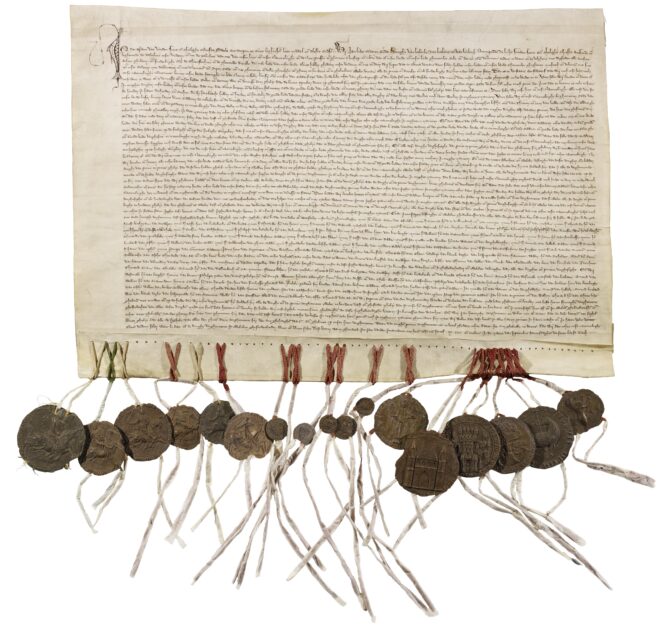
Charter of Kortenberg, 13121
John II died of a complication caused by kidney stones on 17 October 1312 and was buried in the St. Gudula church in Brussels. He was succeeded by his son, John III of Brabant. John also left several known bastard sons by different mistresses, including Jan van Wijfliet (see generation 22).2
John II of Brabant, son of Margaret of Flanders
John II in chronicles
The “Brabantsche Yeesten” [acts of Brabant] book IV describes the wives and children of Duke John I of Brabant (translation):
He [John I] took as wife Margaret, King Philip’s daughter of France. Margaret and her child both died in labor, and he thereafter took another wife, also named Margaret, who was Count Guy of Flanders’ daughter, by whom he gained four children. The oldest was called John, the other brother Geoffrey, who departed this world while young, and one called Margaret who became Empress, and the other Marie who became the count of Savoy’s wife.3
This manuscript indicates that John II of Brabant was the son of John I of Brabant and his second wife Margaret of Flanders. This chronicle was written by Jan van Boendale, a town secretary in Antwerp in the early 1300s, so he was not an eye witness. The surviving manuscript copy at the Royal Library of Belgium dates from the early 1400s.
Book V of this chronicle, continued by another writer and written around 1430, talked about what happened after the death of John I of Brabant (translation):
When this noble man was dead
His son John remained as duke.
He was procreated, as I read
by Margaret, who was daughter
Of count Guy in Flanders.4

Fragment of book V
The “Genealogia illustrissimorum ducum Lotharingie et Brabantie” describes (translated abstract):
John [I] duke of Lorraine and Brabant took Margaret daughter of King Louis of France as his wife, with whom he had a son after which she died. Afterward he took Margaret daughter of Guy count of Flanders as his wife, with whom he procreated two sons John and Geoffrey. Geoffrey died young. His son John succeeded him and took as his wife Margaret the daughter of Edward King of England.5
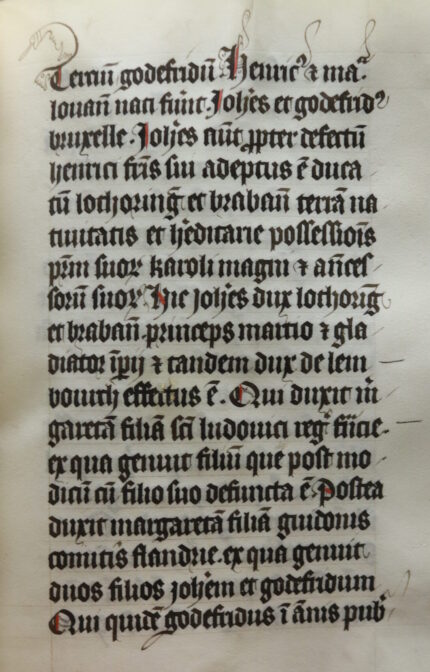
Genealogy manuscript. Photo by author.
The Hertogenboek (book of Dukes), a book about the Dukes of Brabant printed in 1565 based on older manuscripts, gives a short biography of Duke John II of Brabant that also names his parents:
John II the son of John and lady Margaret daughter of Guy count of Flanders, was the fourth Duke of Brabant in the year xii.c.xciiii [1294] and reigned for xix [19] years. His wife was Margaret daughter of King Edward of England. He died in the year xiii.c.xii [1312] and lies buried in Brussel in Ter Soelen.6
The book is not contemporary but provides a nice (fantasy) print of John.
A third chronicle, the Historia rerum gestarum a Brabantiæ ducibus (History of the deeds and acts of the dukes of Brabant) was first published in Antwerp in 1526 and republished in 1665. It provides the following information about John II of Brabant and his parents:
John [I] married Margaret, daughter of King Philip of France, and loved her like no other. But she died in childbirth. He then married again, also to a Margaret, the daughter of Guy, count of Flanders. With her he got two sons, John and Geoffrey, who died at a young age. There were two daughters as well, Margaret and Maria.
[…]
After his father’s death, John II succeeded him. This John married the daughter of King Edward I of England. Her name was Margaret, with whom he had a son. The magnificent courtyard in the castle of Tervuren was the work of this Duke.
John II died after a reign of nineteen years in Tervuren, because of bladder stones. He was buried in Brussels in the St. Gudula church. No ruler had such a dislike to warfare, but when he could not avoid it, he waged war with all his might.7
“Van Brabant die excellente cronike” [the excellent chronicle of Brabant], published in 1530, gives a family tree, showing John II as the son of John I.8
All these chronicles agree that John II duke of Brabant was the son of John I Duke of Brabant by his second wife Margaret of Flanders. These chronicles are lovely to look at and provide us with nice illustrations for this blog post, but their value as evidence is limited. They were created after the events, sometimes centuries later. We don’t know what their sources were, and we don’t know if they were created independently or built on each other. Original records are needed to verify the information.
Husband of Margaret of England
A detail from the chronicles that can be verified is John II of Brabant’s marriage to Margaret, daughter of King Edward I of England.
On 22 January 1279, Edward, King of England, Lord of Ireland and Duke of Guyenne let known his intentions to marry his daughter Margaret to John, oldest son of John, Duke of Lorraine and Brabant. The original charter survives.9 A few months later, John, Duke of Lorraine and Brabant, assigned to Margaret, eldest daughter of Edward of England, future spouse of his eldest son John, 4,000 pounds as her dowager rights.10 The charter survives in the form of a “vidimus” [literally: seen; a charter that certifies the existence of another charter] delivered to Edward II in 1312.
A surviving illuminated family tree of the Kings of England from the early 1300s shows “Margarite duchesse de Brab[ant]” [Margaret, duchess of Brabant] as one of the children of king Edward.11
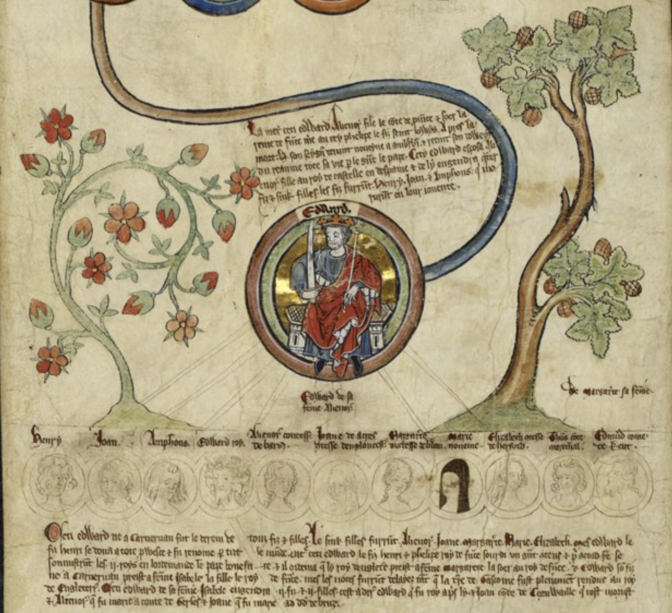
Family Tree of Edward, King of England
Son of John of Brabant
The marriage contract to Margaret of England named John as the son of John of Brabant. Other charters identify John [II] of Brabant as the son of John [I] of Brabant as well. The original charters do not include the numerals, which can make it complicated to identify the different same-named people.
On 3 May 1292, John, count of Brabant, requested several nobles to ratify his agreement with the city of Den Bosch. He named his son John as one of the nobles.12
On 24 March 1293, John I duke of Brabant certified that a gift to him by owners of domains in his duchy was incidental and did not incur recurring obligations. The charter was issued with consent of “Jehan nostre aisneit fil” [John, our oldest son].13
On 25 January 1295, John II paid a debt incurred by the late John I, duke of Brabant, owed to John lord of Cuijk.14 His payment of the debt is consistent with him being the son of John I.
Margaret, wife of John I of Brabant
On 29 June 1280, John I confirmed donations to the abbey at Oudergem, with consent of “coniugis et consortis nostre domine Margarete ducisse Brabantia” [wife and consort our lady Margaret duchess of Brabant].15
The original does not survive, but a copy was entered into the cartulary of Brabant. While the record does not list her origins or parentage, it confirms the first name of John I of Brabant’s spouse in 1280 was Margaret.
John II, nephew of John of Namur and Guy and Robert of Flanders
John II Duke of Brabant referred to his uncles in several charters:
- On 11 March 1298, John, duke of Lorraine, Brabant and Limburg, discharged his uncle, John of Namur, son of Guy, count of Flanders and marquis of Namur, of his caution against Amadeus V, count of Savoy, on the occasion of the marriage contract between the latter and Mary, sister of the duke.16
- On 13 June 1306, Robert, count of Flanders, and John, duke of Lorraine, Brabant and Limburg, name John of Flanders, count of Namur and Guy of Flanders, their respective brothers and uncles, as arbiters in their dispute with William, count of Hainaut, Holland, and Zeeland and Lord of Friesland.17
- On 18 April 1309, John, duke of Lorraine and Brabant, discharged his uncle, John I count of Namur, of the caution for the sum of 12,000 Parisian pounds due to Berthold and Simon Philippe, merchants in Pistoia.18
- On 30 April 1311, John, duke of Lorraine and Brabant, discharged his uncle, John I, count of Namur, of the caution against the Lombards of Brabant.19
These records show that John [II] duke of Brabant was the nephew of John count of Namur, who was the son of Guy, count of Flanders. That is consistent with John II of Brabant’s mother being the daughter of Guy of Flanders. The records showed that John of Namur acted as bondsman for his nephew on several occasions, and that John II of Brabant was heavily in debt.
The 1306 record names John II of Brabant as the nephew of John of Flanders count of Namur and of Guy of Flanders, and names John of Namur and Guy of Flanders as the brothers of Robert, count of Flanders. This indicates that John of Flanders count of Namur, Guy of Flanders, and Robert count of Flanders were all brothers and siblings to John II duke of Brabant’s mother.
A charter from 1296 confirms that Guy and Robert were also the sons of Guy count of Flanders. On 20 July 1296, Guy count of Flanders and Guy, his son, quitclaimed the late Floris V count of Holland and his son John I of Holland for their rights in Zeeland. The charter was confirmed by Guy’s son Robert.20
All these charters are consistent with the information from the chronicles that John II was the son of Margaret, daughter of Guy, count of Flanders.
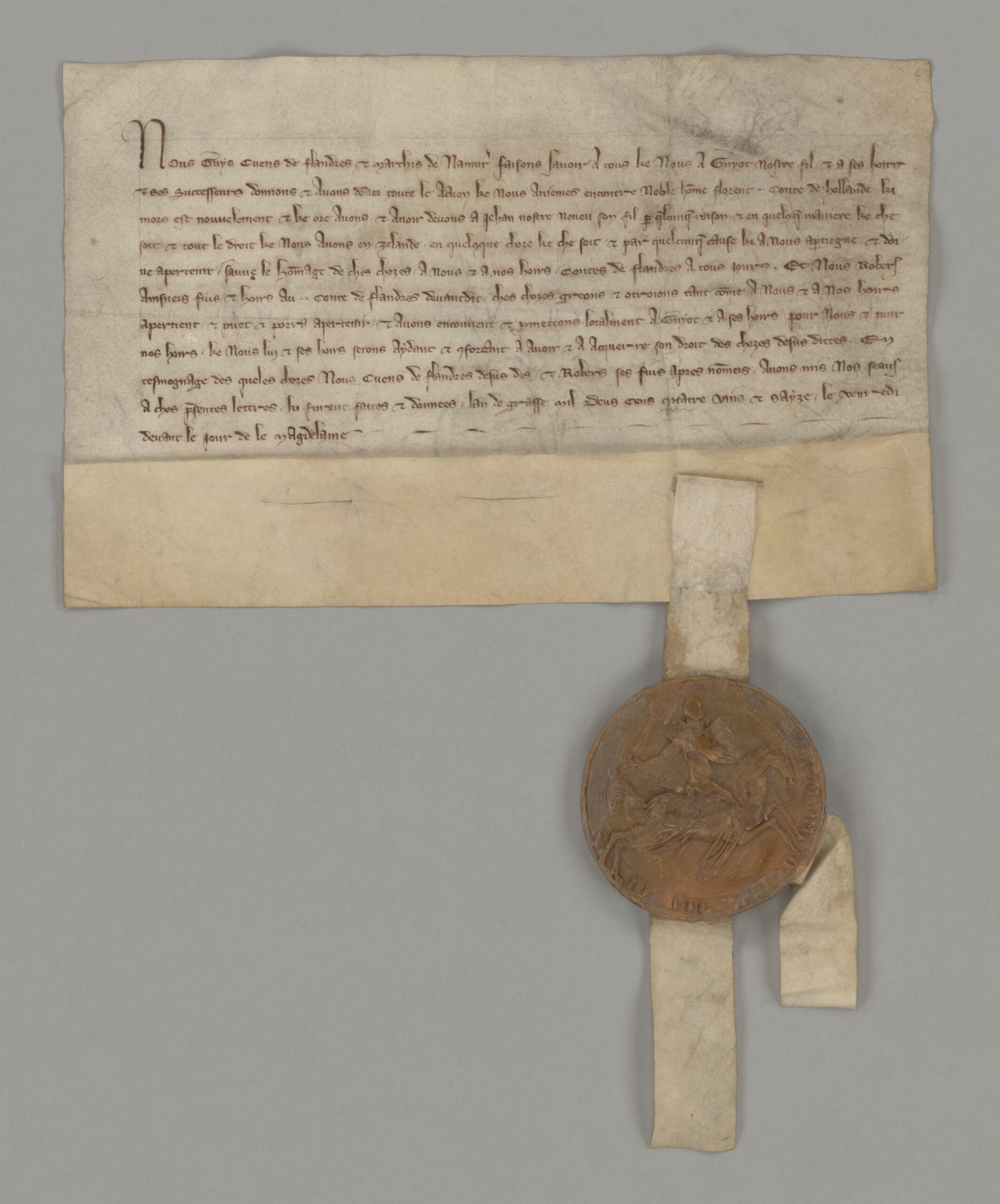
Charter of 20 July 1296
Conclusion
All the evidence agrees that John II duke of Brabant was the son of John I duke of Brabant and Margaret, the daughter of Guy, count of Flanders.

Chronicles name John I of Brabant and his second wife Margaret of Flanders as the parents of John II. John II is named as the son of John I in the contract for his marriage to Margaret of England and in a charter of 1292. John I’s wife was Margaret according to a copied charter from 1280. Charters from 1298 to 1311 list John II together with his uncles John of Namur, Robert of Flanders, and Guy of Flanders, all sons of Guy count of Flanders. These charters confirm his mother was a daughter of count Guy. No evidence was found to contradict the identification of John II of Brabant’s mother as Margaret of Flanders.
That’s twenty-three generations down, just five more to go!
Next up: Generation 24 – Margaret of Flanders.
Sources
- John II, Duke of Brabant, charter of Kortenberg (27 September 1312); call no. CH#68, Ancien Régime of the City of Antwerp, Felix Archives, Antwerp, Belgium; consulted as finding aid and images, Felix-Archief (https://felixarchief.antwerpen.be/detailpagina?invnr=CH_68 : accessed 4 January 2020).
- Many publications describe the lives of the Dukes of Brabant. See for example R. van Uytven, et al, editors, Geschiedenis van Brabant van het hertogdom tot heden (Zwolle: Waanders, 2006), 103-109. Also, Klaas Jansma and Meindert Schroor, Tweeduizend Jaar Geschiedenis van Noord-Brabant (Leeuwarden: Inter-Combi van Seijen, 1987), 102-107. Also, Jan Romein, “Jan II,” in P.C. Molhuysen, ed., Nieuw Nederlands Biografisch Woordenboek, vol. 10 (Leiden: Sijthoff, 1937), 417-420.
- Jan van Boendale, “Brabantsche Yeesten,” book IV, fol. 36v; ms. IV 684, Royal Library of Brussels; consulted as Koninklijke Bibliotheek Brussel (https://uurl.kbr.be/1065581 : accessed 12 November 2019).
- “Brabantsche Yeesten,” book V, p. 279; ms. LTK 1019, Leiden University Library; digitized at “Digital collections,” Leiden University Libraries (https://digitalcollections.universiteitleiden.nl/view/item/877816 : accessed 22 December 2019).
- “Genealogia illustrissimorum ducum Lotharingie et Brabantie, prosapia scilicet Karoli Magni Genealogia ducum Brabantiae ampliata,”; ms. 10953, Royal Library of Belgium, Brussels, Belgium.
- Jan Mollijns, Afcoemste ende genealogie der hertogen ende hertoghinnen van Brabant (Antwerp, 1565); consulted as “Hertogenboek,” Provincie Noord-Brabant (https://www.brabant.nl/subsites/het-nieuwste-brabant/eregalerij/1565-hertogenboek : accessed 28 October 2019).
- Adrianus Barlando, Historia Rerum Gestarum a Brabantiæ Ducibus (Brussels: Franciscus Foppens, 1665), 36-47; imaged at Google Books (http://books.google.com/books?id=kcwQT7tCvGoC : accessed 12 November 2019).
- Jan van Naeldwijk, Van Brabant die Excellente Cronike (Antwerp, 1530); consulted as “Special collections,” Universiteit Utrecht (http://objects.library.uu.nl/reader/resolver.php?obj=000977980&type=2 : accessed 4 January 2020).
- Edward, King of England, prenuptial agreement for his daughter Margaret to John Duke of Lorraine and Brabant, charter (22 January 1279); call no. 101, Account Chamber, charters and cartularies of the Duchy of Brabant, Limburg, and Over-Meuse, Record Group I 282; National Archives of Belgium, Brussels.
- John Duke of Brabant, bride gift to his son’s future wife Margaret daughter of Edward King of England, charter, undated [March 1279]; call no. 102, RG I282, National Archives of Belgium. The original charters were consulted and photographed, but permission was not received to publish them.
- Genealogical roll chronicle of the English Kings, 1st quarter of the 14th century, before 1308, membrane 7, from Henry III to Edward III; Ms. Royal 14 B VI, British Library; digitized at “Catalogue of Illuminated Manuscripts,” British Library (http://www.bl.uk/catalogues/illuminatedmanuscripts/record.asp?MSID=18941&CollID=16&NStart=140206 : accessed 25 December 2019).
- John I duke of Brabant, privileges to Den Bosch, charter (3 May 1292); call no. 3258, City administration of ‘s-Hertogenbosch, Record Group 1; Erfgoed ‘s-Hertogenbosch, ‘s-Hertogenbosch; scan provided by Erfgoed ‘s-Hertogenbosch.
- H.P.H. Camps, compiler, Oorkondenboek van Noord-Brabant tot 1312, vol. I, De Meijerij van ‘s-Hertogenbosch, section 1 (690-1294), p. 594-597, charter 491; citing Leuven, Univ.Bibl. dep. arch. ms. II 65 [ms. II 65, University Library in Louvain, Belgium]. The publication includes a full transcription.
- John I of Cuijk, charter about debt of John I of Brabant (25 January 1295); cartulary of Brabant, 1168-1324, fol. 107r; call no. 1 (cartulary XV), account chamber of Brabant, National Archives of Belgium, Brussels, Belgium. The Belgian archives did not give permission to reproduce the photographs I made. Scan without rights statement found at “nr. 1295.01.25,” Digitaal Oorkondenboek Noord-Brabant (http://www.donb.nl/database/weergave/oorkonde/12950125uitgaveDONB2011 : accessed 4 January 2020).
- Duchy of Brabant, cartulary XXII; call no. 8, Account Chamber of Brabant, National Archives of Belgium, Brussels, Belgium. Permission was not received to publish the photos.
- Jean II duke of Lorraine and Brabant to Jean of Namur, charter (11 March 1298); call no. 292, charters of the counts of Namur, Record Group I87, National Archives of Belgium, Namur; consulted as finding aid and images, Archives in Belgium (http://search.arch.be : accessed 21 November 2019), accessible in reading rooms of the National Archives of Belgium. Unfortunately, permission to reproduce the charters in this blog post has not been received.
- Robert Count of Flanders, John Duke of Lorraine, William count of Hainaut, appointment of arbiters, charter (13 June 1306); call no. 208, Account Chamber, charters and cartularies of the Duchy of Brabant, Limburg, and Over-Meuse, Record Group I 282; National Archives of Belgium, Brussels. The original charter was consulted and photographed but permission has not been granted to reproduce it here.
- Jean II duke of Lorraine and Brabant to Jean I count of Namur, charter (18 April 1309); call no. 348, RG I87.
- Jean II duke of Lorraine and Brabant to Jean I count of Namur, charter (30 April 1311); call no. 376, RG I87.
- Guy [sr] and Guy [jr] of Flanders to Floris and John of Holland, quitclaim, charter (20 July 1296); call no. 192, Counts of Holland, Record group 3.01.01, National Archives, The Hague; consulted as finding aid and images, Nationaal Archief (https://www.nationaalarchief.nl/onderzoeken/archief/3.01.01/invnr/192/file/NL-HaNA_3.01.01_192_R : accessed 18 March 2023).
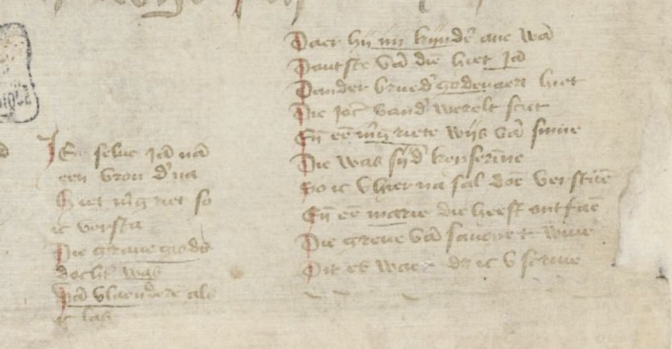
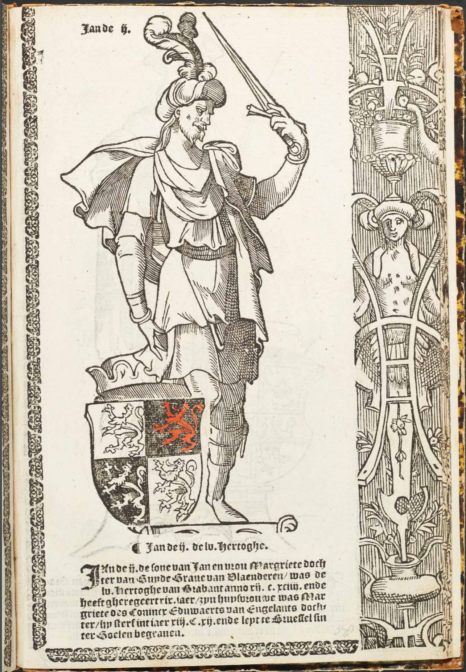
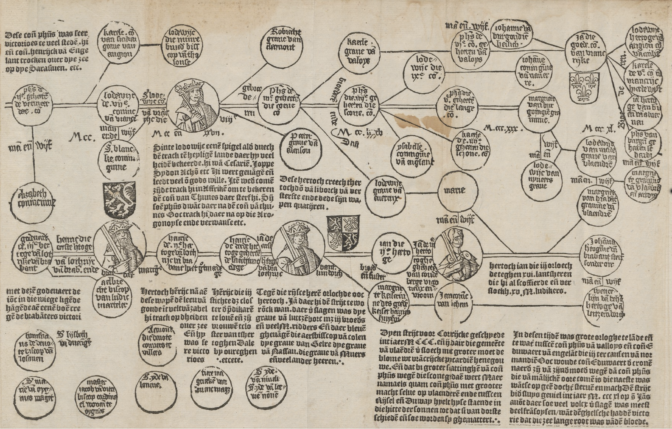
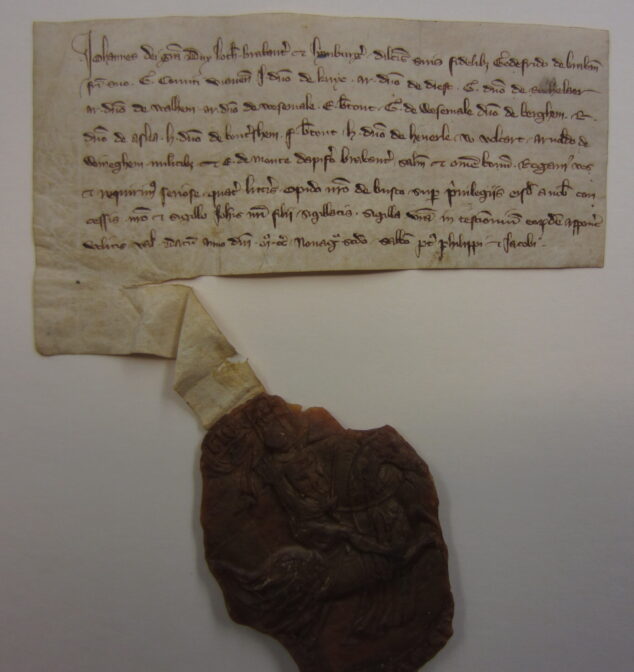



I admire your perseverance!! I don’t know if I could keep working that long.
Shirley
And the plot thickens . . .
We all know who dunnit, but how does the mystery get unraveled, that’s what keeps me reading.
This series is so very interesting. I’m cheering you on!
Thanks for including the biography!
This is really amazing! First the trail that lead you to this point in history. Second it never fails to amaze me how documents survive for so many centuries. So Yvette is of royal blood.!
At first I couldn’t figure out why I could not find the link to the next generation, then realized it hasn’t been uploaded yet. It’s like binge watching a Netflix series and suddenly realizing that we have to wait until the next episode is released.
Wow my earlier comment almost looks like a complaint but it is not meant to be. Thank you for sharing your journey.
I took it as a compliment ? The next generation will require research in Belgium and France. I’d originally planned to go there this month, but I’m quarantined and the archives are closed so it will be a while.